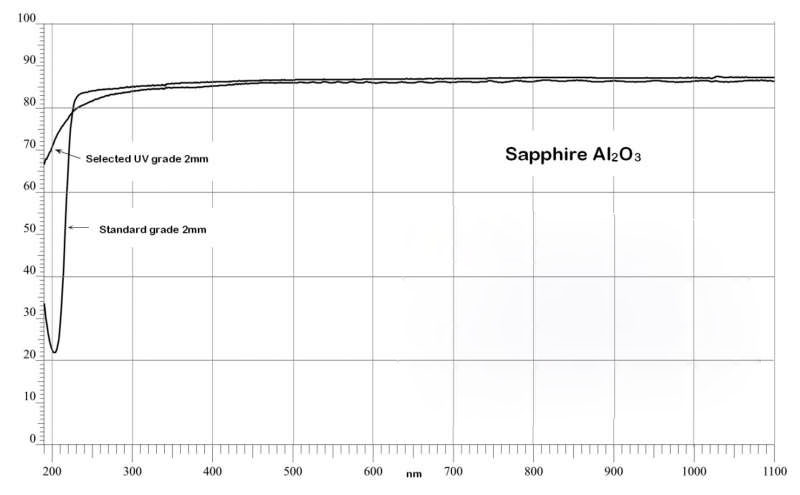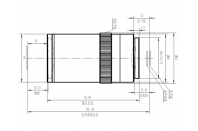Sapphire (Al2O3)
Sapphire, chemical formula Al2O3 is a transparent material with incredible mechanical toughness and strength, excellent thermal properties, dielectric properties, and anti-corrosive characteristics. Sapphire also features wide optical transmission from UV to mid-IR, it is scratch-resistant in extreme, ranking 9 on the Mohs scale. Furthermore, sapphire can remain stable in high-temperature environments, with its melting point reaching 2030℃. Therefore an extensive scope of fields including industrial components, national defense, scientific research, and pharmaceuticals gravitate towards sapphire. Sapphire is becoming more and more prevalent as the material for manufacturing solid-state lasers, optical windows, semiconductor substrates, and various optical components where high thermal loads, high pressure, scratch and wear resistance, corrosive atmospheres, and low friction must be taken into consideration.
The Structure of Sapphire:
Sapphire is a corundum composed of Aluminum Dioxide (Al2O3) arranged in 3D-regular, periodical, and reduplicated crystalline state of hexagonal or cubic structures.
Gamma, beta, alpha, eta, zeta, theta, kappa, rho, and chi sapphires are the nine kinds of sapphire that have been identified to date. The sapphire chosen to make sapphire windows is Alpha Sapphire, manufactured in labs and factories using particular artificial methods. The produced sapphire or sapphire glass is colorless, has higher Al2O3 purities, excludes water, and has more organized, predictable micro-structures than natural sapphire, making it better equipped to meet industrial and optical-grade requirements. Keep in mind that all sapphires are single crystals, and during the growth and cutting processes, sub-grains are avoided all the time.
Alpha-Sapphire has a hexagonal structure. The lattice constant is a=b=4.758A, c=12.991A. The atomic structure of alpha-sapphire used to produce sapphire windows is shown in the figure below. The left half of the figure shows that alpha-sapphire constitutes hexagonal-closest piled oxide floors, and the 3/2 gaps of the octahedron are filled with Al3+ ions. The right part of the figure illustrates six floors of Al2O3 unit cells arranged in ARAB manners. Each floor contains 3 oxide atoms and 18 oxide atoms in total. Regarding the Al atoms, on the 1 and 4 floors, there are two each, the remaining 4 floors contain 3 each, so that will be 12 Al atoms in total.

Atomic Structure of Alpha Single Crystal Sapphire (Alpha-Al2O3)
Orientations of Sapphire:
The orientation of a crystal is a vector describing a random line connecting two nodes on the lattice. The distribution and arrangement of the atoms alter along different directions or upon various lattice planes because crystals are anisotropic. As a result, even identical crystals with different orientations will exhibit different characteristics and behaviors to a remarkable extent. This is the reason selecting the correct crystal orientations and cutting planes is crucial when manufacturing components and elements designed to fulfill different purposes. The orientation of the sapphire engaged to make components of various purposes will be formulated during the growth and cutting/slicing processes on the account that the selected orientation will optimize the performance.
The sapphire's internal lattices are structured in a hexagonal pattern. The direction of an element's internal architecture throughout production has an impact on how it functions.
As shown in the diagram below, sapphire windows often have the following orientations: "a," "c," "n," and "m. Sapphire is birefringent to a subtle extent and so in critical optical situations, the windows should be specified as 'zero degrees', or 'c-cut'. C-cut sapphire has the birefringence effect removed since it is cut in a direction perpendicular to the c-axis, which is parallel to the sapphire optical axis. When it comes to protecting and packaging usages such as the sight glass of wristwatches, A-cut sapphire is often utilized, which is cut in a direction perpendicular to the A-axis, containing exceptional mechanical hardness and scratch resistance. If unspecified, the component will be of a 'random' cut, but it is worth noting that this is, for the most part, 60° to the optic axis as this is the 'softest' direction for the sawing. Random-cut sapphire is common because of lower costs and is acceptable if there are no stringent requirements about optical or mechanical qualities. However, as mentioned above, because the behavior of sapphire varies depending on orientations, random orientation might be subject to spontaneous variations of strength and other properties in the final product.
Orientation Index:
C-plane (0001) = Z-cut
A-plane (11-20) = Y-cut
M-Plane (10-10) = X-cut
R-Plane (10-10)


The Lattice Structure of Sapphire and Common Sapphire Crystal Orientations
Mechanical Properties of Sapphire:
The mechanical properties of single-crystal sapphires are relevant to their densities, the greater the densities, the better the mechanical properties. Single crystal sapphires with 100% Al2O3 composition are supposed to have theoretical densities of 3.68g/cm3. Under such presumption, the mechanical properties of sapphire are the best. Its anti-compression strength is between 1.9-24 GPa. And the Young’s Modulus of sapphire is 380 Gpa, which is about twice the magnitude of iron’s 200 GPa. However, when sapphire reaches the temperature of 1200°C, its elastic coefficients begin in a drastic manner.
The enormous hardness is another important feature of sapphire, its Mohs hardness is 9, ranking right after diamond, indicating that optical components crafted using sapphire are resistant to scratch and wear. The hardness of sapphire is also proportionate in a positive manner to the purities of sapphire.
Thermal Properties of Sapphire:
Thermal properties in main include thermal conduction coefficients, thermal diffusion coefficients, specific heat, and thermal expansion coefficients. The thermal properties of sapphire relate to the purities of sapphire. In common circumstances, the higher the purities, the higher the thermal conduction coefficients and thermal diffusion coefficients, while there is no regular pattern between Al2O3 purities and the magnitude of thermal expansion coefficients. In fact, manufacturers seem unable to agree on the thermal expansion coefficient of sapphire, Whilst there might be some variation due to the method of growth, and of course, due to the orientation, this variation is inexplicable.
Optical Transmission of Sapphire:
The optical transmission range of sapphire is wide, 225-5500mm, extending from UV to IR spectra.
No matter what the optical grades are, IR transmission is not a concern for uncoated sapphire above a wavelength of about 5000 nm. The UV range is where caution should be exercised since the transmission from 140 nm to 240 nm is susceptible to both interstitial vacancies and quite minor amounts of impurities. Although small aperture sapphire windows constructed from the aforementioned Verneuil "half-ingots" often contribute to good transmission, conventional sapphire material tends to demonstrate a poor UV performance at 160nm to 240nm. The major factor contributing to poor UV performance, aside from contaminants, is a wide absorption at 205 nm brought upon with interstitial vacancies.
There is also UV-grade sapphire, which is prepared to cater to UV transmission requirements. The UV sapphires will go through specific heat treatments to remove interstitial vacancies, which are reversible using heat.
Transmission Curve of Sapphire:


Sapphire Growth:
In the past, the Verneuil Method was developed to fabricate synthetic sapphire. This process makes use of flame fusion: Al2O3 powders are added to the OH flame during the process, and the melted drops congeal on a cooled seed rod. However, due to the difficulties in controlling flame heat, which results in fractures in the final product, and the substantial depletion of Al2O3 during the flame fusion process, which raises the cost of production, this approach is no longer effective in the current market. What’s more, the fact that a natural cleavage plane will be introduced down the middle of the sapphire ingot when using this approach makes it difficult to produce large-diameter sapphires.
For now, the SAPMAC Method and the Kyropoulos Method (KY Method) are utilized the most often to create optical-grade single-crystal sapphire. The Czochralski method, which the KY method is a modification of, leverages uplifting as the motivating force of growth, and the KY method relies on the delicate modulation of temperature changes to grow sapphire. The apparatus and operations of both methods are analogous.
The Kyropoulos process involves melting a specific volume of Al2O3 inside a crucible inside a KY growth furnace, then dipping a rod with a seed sapphire crystal connected at the bottom into the resulting solution. The remaining portion of sapphire crystal is produced utilizing a gradual and slow cooling procedure of the solution after a mild pulling up of the rod is done to extract the first head sector of sapphire crystal.
The Kyropoulos method is competent for growing bulk sapphire crystals with diameters greater than 100mm. And because there is little lifting up during the growth phase of sapphire, so the temperature gradient could be modulated with higher precision, minimizing the densities of lattice dislocation and thermal stress.
Another innovative method built on the KY method and the Czochralski method is the SAPMAC Method. The SAPMAC approach, in contrast to the other two, uses fewer lifting-ups and more sensitive temperature regulation, separated into segments that correspond to the sapphire's growth phase.
Appendix: Sapphire Datasheets:
Sapphire Properties:
Lattice Constants | a=4.765, c=13.00 |
Transmission Range | 0.25 to 5.5 μm |
Refractive Index | No 1.75449; Ne 1.74663 at 1.06 μm (1) |
Reflection Loss | 14% at 1.06 μm |
Absorption Coefficient | 0.3 x 10-3 cm-1 at 2.4 μm (2) |
Reststrahlen Peak | 13.5 μm |
dn/dT | 13.1 x 10-6 at 0.546 μm (3) |
dn/dμ = 0 | 1.5 μm |
Density | 3.98 g/cc |
Melting Point | 2040°C |
Thermal Conduction Coefficients | 27.21 W m-1 K-1 at 300K |
Thermal Expansion | 5.6 (para) & 5.0 (perp) x 10-6/K * |
Hardness | Knoop 2000 with 2000g indenter |
Specific Heat | 763 J Kg-1 K-1 at 293K (4) |
Dielectric Constant | 11.5 (para) 9.4 (perp) at 1MHz |
Youngs Modulus (E) | 345 GPa |
Shear Modulus (G) | 148.1 GPa |
Bulk Modulus (K) | 240 GPa |
Elastic Coefficients | C11=496 C12=164 C13=115 C33=498 C44=148 |
Apparent Elastic Limit | 300 MPa (45,000 psi) |
Poisson Ratio | 0.25-0.30 |
Solubility | 98 x 10-6 g/100g water |
Molecular Weight | 101.96 |
Class/Structure | Trigonal (hex), R3c |
Sapphire Refractive Index
No = Ordinary Ray Ne = Extraordinary Ray
| µm | No | Ne | µm | No | Ne | µm | No | Ne |
| 0.193 | 1.9288 | 1.9174 | 0.213 | 1.8890 | 1.8784 | 0.222 | 1.8754 | 1.8650 |
| 0.226 | 1.8702 | 1.8599 | 0.244 | 1.8506 | 1.8407 | 0.248 | 1.8470 | 1.8372 |
| 0.257 | 1.8393 | 1.8297 | 0.266 | 1.8330 | 1.8236 | 0.280 | 1.8244 | 1.8151 |
| 0.308 | 1.8110 | 1.8020 | 0.325 | 1.8047 | 1.7958 | 0.337 | 1.8001 | 1.7921 |
| 0.351 | 1.7969 | 1.7882 | 0.355 | 1.7960 | 1.7883 | 0.442 | 1.7804 | 1.7721 |
| 0.458 | 1.7784 | 1.7702 | 0.488 | 1.7753 | 1.7671 | 0.515 | 1.7730 | 1.7649 |
| 0.532 | 1.7717 | 1.7636 | 0.590 | 1.7680 | 1.7600 | 0.633 | 1.7659 | 1.7579 |
| 0.670 | 1.7643 | 1.7563 | 0.694 | 1.7634 | 1.7554 | 0.755 | 1.7614 | 1.7535 |
| 0.780 | 1.7607 | 1.7527 | 0.800 | 1.7601 | 1.7522 | 0.820 | 1.7596 | 1.7517 |
| 0.980 | 1.7561 | 1.7482 | 1.064 | 1.7545 | 1.7466 | 1.320 | 1.7501 | 1.7423 |
| 1.550 | 1.7462 | 1.7384 | 2.010 | 1.7375 | 1.7297 | 2.249 | 1.7323 | 1.7243 |
| 2.703 | 1.719 | 1.711 | 2.941 | 1.712 | 1.711 | 3.333 | 1.701 | 1.693 |
| 3.704 | 1.687 | 1.679 | 4.000 | 1.674 | 1.666 | 4.348 | 1.658 | 1.65 |
| 4.762 | 1.636 | 1.628 | 5.000 | 1.623 | 1.615 | 5.263 | 1.607 | 1.599 |
Related Products
Tags: Sapphire (Al2O3)



